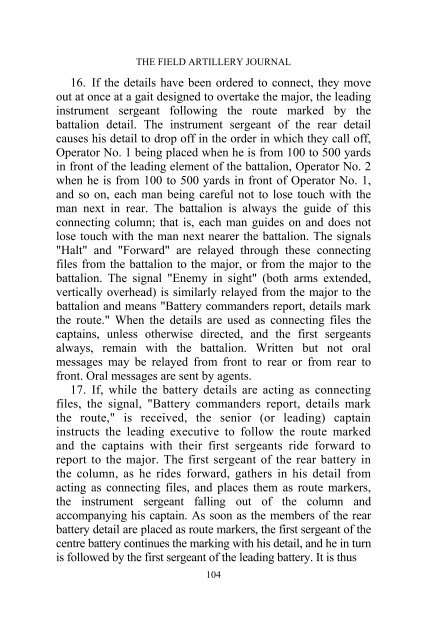the field artillery journal - Fort Sill - U.S. Army
the field artillery journal - Fort Sill - U.S. Army
the field artillery journal - Fort Sill - U.S. Army
Create successful ePaper yourself
Turn your PDF publications into a flip-book with our unique Google optimized e-Paper software.
THE FIELD ARTILLERY JOURNAL<br />
16. If <strong>the</strong> details have been ordered to connect, <strong>the</strong>y move<br />
out at once at a gait designed to overtake <strong>the</strong> major, <strong>the</strong> leading<br />
instrument sergeant following <strong>the</strong> route marked by <strong>the</strong><br />
battalion detail. The instrument sergeant of <strong>the</strong> rear detail<br />
causes his detail to drop off in <strong>the</strong> order in which <strong>the</strong>y call off,<br />
Operator No. 1 being placed when he is from 100 to 500 yards<br />
in front of <strong>the</strong> leading element of <strong>the</strong> battalion, Operator No. 2<br />
when he is from 100 to 500 yards in front of Operator No. 1,<br />
and so on, each man being careful not to lose touch with <strong>the</strong><br />
man next in rear. The battalion is always <strong>the</strong> guide of this<br />
connecting column; that is, each man guides on and does not<br />
lose touch with <strong>the</strong> man next nearer <strong>the</strong> battalion. The signals<br />
"Halt" and "Forward" are relayed through <strong>the</strong>se connecting<br />
files from <strong>the</strong> battalion to <strong>the</strong> major, or from <strong>the</strong> major to <strong>the</strong><br />
battalion. The signal "Enemy in sight" (both arms extended,<br />
vertically overhead) is similarly relayed from <strong>the</strong> major to <strong>the</strong><br />
battalion and means "Battery commanders report, details mark<br />
<strong>the</strong> route." When <strong>the</strong> details are used as connecting files <strong>the</strong><br />
captains, unless o<strong>the</strong>rwise directed, and <strong>the</strong> first sergeants<br />
always, remain with <strong>the</strong> battalion. Written but not oral<br />
messages may be relayed from front to rear or from rear to<br />
front. Oral messages are sent by agents.<br />
17. If, while <strong>the</strong> battery details are acting as connecting<br />
files, <strong>the</strong> signal, "Battery commanders report, details mark<br />
<strong>the</strong> route," is received, <strong>the</strong> senior (or leading) captain<br />
instructs <strong>the</strong> leading executive to follow <strong>the</strong> route marked<br />
and <strong>the</strong> captains with <strong>the</strong>ir first sergeants ride forward to<br />
report to <strong>the</strong> major. The first sergeant of <strong>the</strong> rear battery in<br />
<strong>the</strong> column, as he rides forward, ga<strong>the</strong>rs in his detail from<br />
acting as connecting files, and places <strong>the</strong>m as route markers,<br />
<strong>the</strong> instrument sergeant falling out of <strong>the</strong> column and<br />
accompanying his captain. As soon as <strong>the</strong> members of <strong>the</strong> rear<br />
battery detail are placed as route markers, <strong>the</strong> first sergeant of <strong>the</strong><br />
centre battery continues <strong>the</strong> marking with his detail, and he in turn<br />
is followed by <strong>the</strong> first sergeant of <strong>the</strong> leading battery. It is thus<br />
104

















